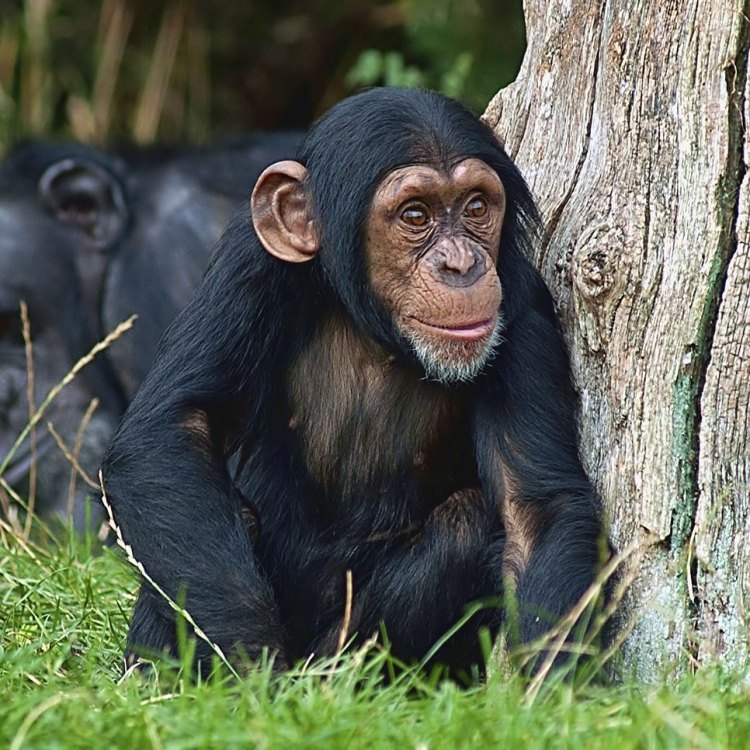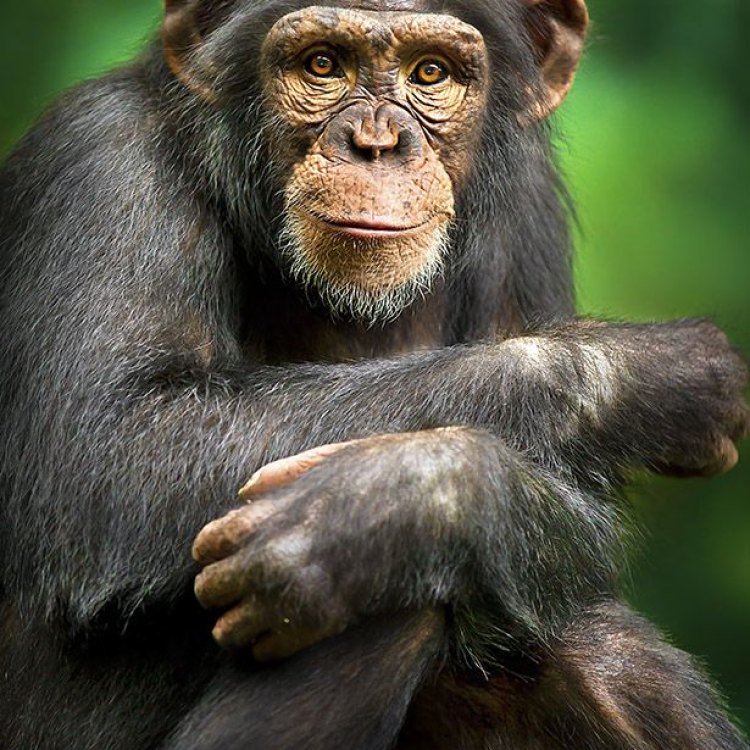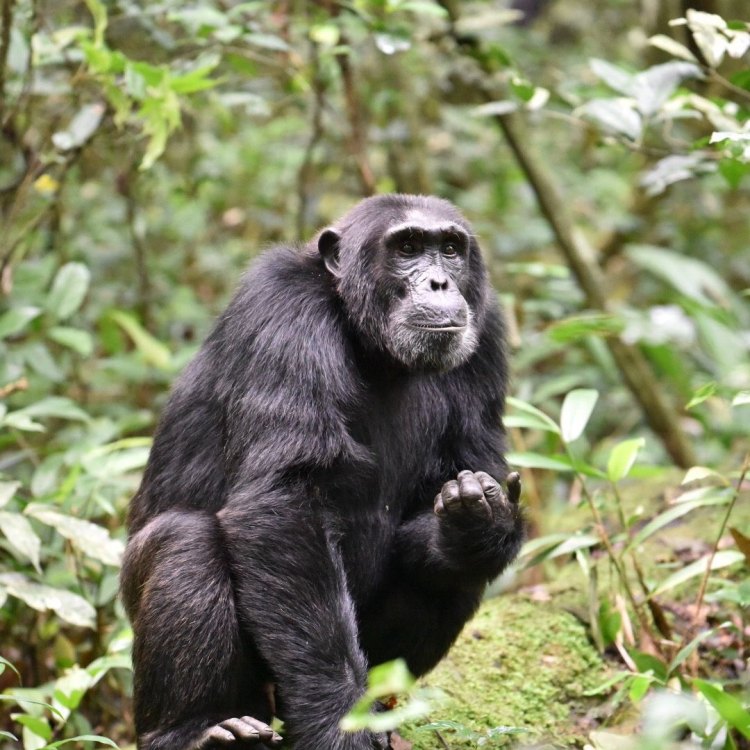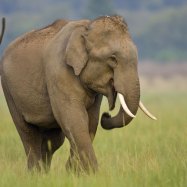
Chimpanzee
1 - 1.7 meters
Discover the fascinating world of Chimpanzees, our closest relatives in the animal kingdom. These intelligent creatures can be found in Central and West Africa, with a body shape similar to humans and a length of 1-1.7 meters. Fun fact: their family, Hominidae, includes other great apes like gorillas and orangutans. #Chimpanzee #AnimalFacts #PrimateKingdom
Animal Details Summary:
Common Name: Chimpanzee
Kingdom: Animalia
Habitat: Tropical Rainforests
Discovering the Fascinating World of Chimpanzees: A Closer Look at our Intelligent Primate Cousins
When we think of primates, images of monkeys swinging from trees or gorillas pounding their chests often come to mind. However, there is one primate that may be even more fascinating and complex than the rest – the chimpanzee.Considering their close genetic relation to humans, it's no wonder that chimpanzees have captured the hearts and minds of scientists, researchers, and animal lovers alike. From their social intelligence to their advanced problem-solving skills, there is so much to uncover about these incredible creatures Chimpanzee.
In this article, we will dive deep into the world of chimpanzees, exploring their scientific name, habitat, feeding habits, geographical distribution, and more. So, let's start our journey to discover the amazing features of this primate species.
Meet the Chimpanzee
Scientifically known as Pan troglodytes, the common chimpanzee is a primate species belonging to the Kingdom Animalia, Phylum Chordata, Class Mammalia, and Order Primates. They are the closest living relatives to humans, sharing over 98% of their genetic makeup with us.Found primarily in tropical rainforests in Central and West Africa, chimpanzees have captured the curiosity of many scientists and researchers due to their intelligence and behavior that is highly similar to humans. In fact, chimpanzees are considered to have the most complex and developed brains amongst non-human primates.
Life in the Tropical Rainforests
Found in a variety of habitats, including savannas, swamps, and forests, chimpanzees prefer living in tropical rainforests where they have access to food, water, shelter, and other essential resources. Due to their ability to adapt to different environments, they have been observed to live in diverse areas such as grasslands, woodlands, and mountain habitats.Chimpanzees are highly social animals and live in communities called troops, ranging from 15 to 150 individuals Chow Pom. These troops are led by a dominant male known as an alpha male, who is responsible for protecting the group and making decisions for the troop.
Within a troop, there is a complex social hierarchy with female chimpanzees holding a high status and often working together to take care of the younger ones. This cooperation and social structure are essential for their survival in the wild.
Omnivorous Diet
Chimpanzees are omnivores, meaning they have a varied diet, consisting of both plants and animals. They are known to eat over 100 different types of plants, including fruits, leaves, seeds, and flowers. They also consume insects such as termites, ants, and bees, as well as small mammals like monkeys, rodents, and antelopes.In addition to foraging for their food, chimpanzees also use tools to help them access more difficult food sources. For example, they use sticks and rocks to crack open nuts and fruits. They have also been observed using twigs to fish for termites and using leaves as sponges to soak up water for drinking.
Africa's Primate Treasure
Chimpanzees are widely distributed throughout Central and West Africa. Their geographical range extends from countries such as Cameroon, Gabon, and the Democratic Republic of Congo in Central Africa to Guinea, Sierra Leone, and Ivory Coast in West Africa.The distribution of chimpanzees is largely dependent on the availability of food and resources in the area. As they prefer to live in densely forested areas, their numbers have declined due to deforestation and human activities such as hunting and poaching. It is estimated that there are only around 300,000 chimpanzees left in the wild, making them an endangered species.
Similar to Humans, Yet Unique
Chimpanzees share several physical and behavioral similarities with humans, which makes them one of the most interesting primate species to study. They have opposable thumbs and can grasp objects with their hands, just like humans. They also have a similar DNA structure and share many of the same genetic disorders as humans.Their body shape is similar to humans, with long arms and a hunched posture. They have a coat of black, brown, and gray fur, covering most of their body except for their faces, hands, and feet. They have a lifespan of around 50 years in the wild and can weigh up to 70 kilograms.
While chimpanzees may have some similarities to humans, they also possess unique features that make them stand out. For instance, they have longer and more muscular arms compared to their legs, which allows them to swing from tree to tree, known as brachiation. They also have a longer lifespan compared to other primates of similar size.
The Importance of Chimpanzee Conservation
It is no secret that chimpanzees are facing numerous threats to their survival, primarily due to human activities. Deforestation, the pet trade, and poaching are some of the biggest challenges for their conservation. The loss of their natural habitat has driven them to the brink of extinction, and if action is not taken, they may disappear entirely from the wild.However, there is hope. Many conservation efforts are underway to protect this intelligent primate species. Organizations such as the Jane Goodall Institute and the World Wildlife Fund are working tirelessly to raise awareness and advocate for the protection of chimpanzees and their habitats. Governments are also implementing stricter laws and regulations to prevent poaching and illegal trade.
As individuals, we can also do our part by supporting ethical and responsible tourism, choosing sustainable products, and educating ourselves and others about the importance of primate conservation.
Conclusion
Chimpanzees are undoubtedly some of the most intriguing and complex animal species on our planet. With their intelligence, social complexity, and similarities to humans, they have captured our attention and stirred our curiosity. However, it is crucial to remember that they are not just fascinating creatures to be studied, but also living beings that deserve our protection.As we continue to discover more about these incredible primates, it is our responsibility to ensure that they have a future in their natural habitats. Through conservation efforts, research, and education, we can all play a role in preserving the wonder and beauty of chimpanzees, our intelligent primate cousins.

Chimpanzee
Animal Details Chimpanzee - Scientific Name: Pan troglodytes
- Category: Animals C
- Scientific Name: Pan troglodytes
- Common Name: Chimpanzee
- Kingdom: Animalia
- Phylum: Chordata
- Class: Mammalia
- Order: Primates
- Family: Hominidae
- Habitat: Tropical Rainforests
- Feeding Method: Omnivorous
- Geographical Distribution: Central and West Africa
- Country of Origin: Various countries in Africa
- Location: Central and West Africa
- Animal Coloration: Black, brown, and gray
- Body Shape: Similar to humans, with long arms and a hunched posture
- Length: 1 - 1.7 meters

Chimpanzee
- Adult Size: 30 - 60 kg
- Average Lifespan: 40 - 50 years
- Reproduction: Sexual reproduction
- Reproductive Behavior: Polygamous
- Sound or Call: Varied vocalizations
- Migration Pattern: Non-migratory
- Social Groups: Large, multi-male, multi-female groups
- Behavior: Intelligent and social
- Threats: Habitat loss, poaching, and disease
- Conservation Status: Endangered
- Impact on Ecosystem: Seed dispersal
- Human Use: Research and entertainment
- Distinctive Features: Large ears, hairless face, and opposable thumbs
- Interesting Facts: Chimpanzees are the closest living relatives to humans
- Predator: Human

Pan troglodytes
The Fascinating World of Chimpanzees
When it comes to the animal kingdom, there are few creatures as fascinating and awe-inspiring as chimpanzees. These intelligent and social creatures have long captured our curiosity and imagination. In this article, we will dive into the unique features and behaviors of chimps, their impact on the ecosystem, and the threats they face in the wild.Chimpanzees, or Pan troglodytes, are one of the two species of chimpanzee, the other being the bonobo PeaceOfAnimals.Com. These primates are native to Central and Western Africa, with their range extending from Guinea in the west to Tanzania in the east. They thrive in a variety of habitats, from dense rainforests to savannas and even mountainous regions.
One of the most striking features of chimpanzees is their size. As adults, they can weigh anywhere from 30 to 60 kilograms, making them the largest species of ape after gorillas and orangutans. They also have a relatively long average lifespan of 40 to 50 years, with some individuals living up to 60 years in captivity. This extended lifespan is due to their intelligent behaviors, which allow them to adapt and survive in changing environments.
One of the most crucial aspects of a species' survival is its reproductive behavior, and chimpanzees are no exception. These primates engage in sexual reproduction, with females giving birth to a single offspring at a time. However, their reproductive behavior is quite unique, as they are polygamous Cone Snail. This means that they have multiple sexual partners and often form complex social bonds with other individuals in their group.
Speaking of social bonds, chimpanzees are highly social animals. In the wild, they live in large groups consisting of multiple males and females. These groups can range from 15 to over 100 individuals, with varying levels of hierarchy and social structure. They also have a sophisticated communication system, using varied vocalizations to convey different messages to one another.
Unlike many migratory animals, chimpanzees are non-migratory. This means that they do not have a set pattern of migration, but rather stay in their home range for most of their lives. This is due to the abundance of resources in their habitat, such as food and water. However, they have been known to travel short distances in search of food or during breeding season.
With their highly social nature and complex behaviors, chimpanzees have a significant impact on their ecosystem. One of the most vital roles they play is that of seed dispersers. As they travel through their habitat, they feed on various fruits, nuts, and seeds, and then disperse the undigested seeds through their feces. This helps with the growth and diversity of plant species in the area.
Despite their vital role in the ecosystem, chimpanzees are facing numerous threats that endanger their survival. One of the most significant threats is habitat loss due to deforestation, poaching, and disease. As human populations continue to expand, so does the destruction of chimpanzee habitats.
Sadly, chimpanzees are also hunted for their meat, which is considered a delicacy in some cultures. This unsustainable hunting, along with illegal pet trade, has led to a decline in their population, earning them an endangered status on the International Union for Conservation of Nature's (IUCN) Red List.
Aside from their importance in the ecosystem, chimpanzees also hold great significance for human use. They have been studied extensively in the fields of biology, psychology, and neuroscience, providing valuable insights into human evolution and behavior. They have also been used in entertainment, such as in movies and television shows, although this practice is now highly debated and restricted.
When observing a chimpanzee, it's hard not to notice their distinctive features. These primates have large ears, a hairless face, and opposable thumbs. Their ears may look oversized, but they serve both practical and social purposes. They help with thermoregulation, as well as signaling to their group members through ear movements.
Another unique characteristic of chimpanzees is their hairless face. This, along with their expressive eyes, allows them to communicate and express emotions through facial expressions. As for their opposable thumbs, they are essential for gripping branches and tools, which help with various tasks such as gathering food and building nests.
Aside from their physical features, there are many interesting facts about chimpanzees that make them extraordinary creatures. For one, they are the closest living relatives to humans, sharing around 98% of our DNA. This genetic similarity has allowed them to exhibit complex behaviors and cognitive abilities, such as problem-solving, tool use, and even self-awareness.
Unfortunately, the biggest predator of chimpanzees is humans. However, it's not too late to change this narrative and protect these incredible animals. Many organizations and conservation efforts are working towards the preservation of chimpanzee habitats and populations. By supporting these initiatives and raising awareness, we can play our part in securing a better future for these magnificent creatures.
In conclusion, chimpanzees are truly one of a kind. Their large size, intelligence, social behavior, and unique features make them a fascinating subject of study and admiration. However, they also face many challenges in their natural habitat, and it's up to us to take action and ensure their survival for generations to come. Let's work towards a world where these amazing creatures can thrive and continue to inspire us.

Discovering the Fascinating World of Chimpanzees: A Closer Look at our Intelligent Primate Cousins
Disclaimer: The content provided is for informational purposes only. We cannot guarantee the accuracy of the information on this page 100%. All information provided here may change without prior notice.












